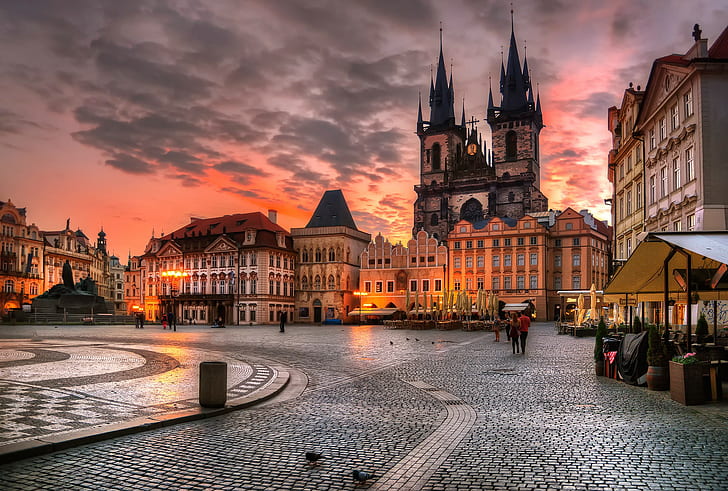🏰 Bohemia: A Central Pillar in the Holy Roman Empire 🏰
In order to fully appreciate the rich Christian heritage of the Czech Lands (and why its deep secularity today is so utterly tragic), we must recognize Bohemia’s strategic and religious significance within the Holy Roman Empire (800-1806 A.D.). Far from being a peripheral state, Bohemia played a decisive role in shaping the political, cultural, and ecclesiastical dynamics of Central Europe. This centrality is summed up in the enduring sentiment—often linked to Otto von Bismarck—that “whoever controls Bohemia, controls Europe.” Whether or not Bismarck himself first uttered these words, the saying encapsulates the profound influence wielded by Bohemia and those who have ruled it over Europe’s destiny.
THE STRATEGIC MAXIM: "WHOEVER CONTROLS BOHEMIA, CONTROLS EUROPE"
This maxim speaks to the geographical and cultural crossroads upon which Bohemia sits. With its position bridging Eastern and Western Christendom, Bohemia and its capital, Prague, became a linchpin in the balance of power in Europe.
Control of Bohemia was not only a matter of territorial dominion but also of cultural influence, intellectual leadership, and economic prosperity. Bohemia's wealth, derived from trade and agriculture, enhanced its standing within the Holy Roman Empire and made it an attractive focal point for scholars, theologians, artists, artisans, and political leaders alike.
Control of Bohemia was not only a matter of territorial dominion but also of cultural influence, intellectual leadership, and economic prosperity. Bohemia's wealth, derived from trade and agriculture, enhanced its standing within the Holy Roman Empire and made it an attractive focal point for scholars, theologians, artists, artisans, and political leaders alike.
The idea behind the phrase is clear: by holding sway over Bohemia—and by extension, Prague—one could exert significant influence over the broader affairs of Central Europe. This notion would resonate with statesmen like Bismarck, who, regardless of the precise origin of the quote, recognized that the cultural and strategic heart of Bohemia was key to controlling the European narrative.
CHARLES IV: ARCHITECT OF PRAGUE’S GOLDEN AGE
Among the towering figures in Bohemian history, Emperor Charles IV (1316-1378 A.D.) stands out as a visionary leader whose impact still echoes today. As both King of Bohemia (1346-1378) and Holy Roman Emperor (1355-1378), Charles IV used his unique position to transform Prague into a vibrant center of imperial power and intellectual life. His reign marked a renaissance for the Czech Lands, redefining the cultural and religious landscape of the region.
One of Charles IV’s most enduring legacies is the founding of Charles University in 1348—the first university in Central Europe. By establishing this institution, Charles IV not only bolstered Prague’s reputation as a beacon of learning and culture but also laid the foundation for a robust clerical and intellectual community within the Holy Roman Empire. Charles University became a magnet for scholars, theologians, and artists from across Europe, playing a central role in training clergy and fostering critical theological and philosophical debates.
The intellectual ferment generated at Charles University had far-reaching consequences. Among its notable alumni and faculty was Jan Hus (1370-1415), whose later work as a reformer would ignite the Bohemian Reformation a century before Martin Luther's Reformation began in nearby Germany (which was also part of the Holy Roman Empire at that time) and profoundly impact the Christian world, which we will look at more in depth in our next chapter. The rigorous training and the vibrant spirit of inquiry that characterized the university under Charles IV’s patronage helped mold Hus’s ideas, setting the stage for a religious transformation that would challenge established ecclesiastical norms and pave the way for modern reform movements.
BOHEMIA AS A CULTURAL AND POLITICAL BRIDGE
Prague’s emergence as a leading center of theology and ecclesiastical authority is inextricably linked to its role as a cultural bridge between Eastern and Westestern Europe. The city’s magnificent churches, monasteries, and educational institutions were not only symbols of religious devotion but also hubs of cultural exchange. This dynamic atmosphere allowed Prague to serve as a meeting point for diverse ideas and traditions, enriching Bohemian identity while reinforcing its central role within the Holy Roman Empire.
Economic prosperity, driven by thriving agriculture and vibrant trade, further solidified Bohemia’s influence. The region’s wealth supported impressive architectural projects and patronized the arts, which, in turn, attracted intellectuals and visionaries eager to contribute to the legacy of a realm that many believed was key to controlling the destiny of Europe.
EXTERNAL PRESSURES AND THE UNIFYING ROLE OF FAITH
During this period, the looming threat of the Islamic Ottoman Empire galvanized the states of the Holy Roman Empire, including Bohemia, to rally around a shared Christian identity. This external pressure not only spurred internal reforms but also reinforced the idea that the control of Bohemia—both as a strategic territory and as a cultural beacon—was essential to safeguarding European Christendom. The unyielding spirit of Bohemia in the face of such challenges further elevated its stature, making it an indispensable guardian of both faith and culture.
✨ REFLECTION
Prague's and Bohemia’s central role in the Holy Roman Empire is a testament to its enduring influence on European political, cultural, and religious life. The sentiment that “whoever controls Bohemia, controls Europe” encapsulates the strategic, economic, and intellectual weight this region has carried throughout history. Through visionary leadership, epitomized by Charles IV’s transformative reign and the founding of Charles University, Bohemia not only nurtured a legacy of learning and reform but also shaped the very course of European history—an influence that continues to resonate as we move toward the chapter on Jan Hus and the Bohemian Reformation.
🙏 PRAYER FOCUS
Let us pray for the Czech Republic and for all who carry forward this legacy of enlightenment and faith. May the spirit of Bohemia’s storied past inspire unity, truth, and the flourishing of the Christian community as we journey together into a new era of understanding and reform.


























